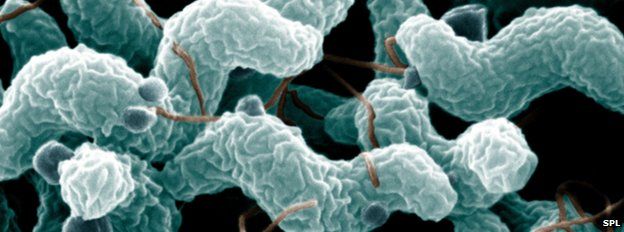Some 73% of fresh shop-bought chicken tested positive for food poisoning bug campylobacter in a year-long study by the Food Standards Agency (FSA).
The survey tested about 4,000 samples of whole raw chickens bought from UK retail outlets and independent stores.
All of the major retailers failed to reach industry targets to reduce the bug over the period of the study.
But the FSA said Marks & Spencer, Morrisons, the Co-op and Waitrose had since seen a fall in contamination.
The four retailers carried out their own case studies to show how their plans to reduce levels of campylobacter are working, the results of which have also been published.
This data – from tests carried out on more recent samples than the FSA study – showed “significant decreases in the incidence of campylobacter on their raw whole chickens”, the agency said.
Campylobacter is the most common form of food poisoning in the UK, with an estimated 280,000 people a year affected by it. Poultry is the source of most cases – although cooking meat properly will kill the bug.
The Campylobacter menace
About 280,000 people discover the gut-wrenching pain of a campylobacter infection each year – symptoms include diarrhoea, stomach pains and cramps, fever, and generally feeling unwell.
The illness usually lasts for a few days but it can lead to long-term health problems, including irritable bowel syndrome and reactive arthritis, or even be fatal.
The overwhelming majority of cases come from contaminated poultry – about four in five – but other sources include red meat, unpasteurised milk and untreated water.
Campylobacter is very easily spread so other foods prepared in the same kitchen, so even if your chicken is thoroughly cooked you may have contaminated something else.
Steps to avoid it include covering and chilling raw chicken, not washing raw chicken (as washing may spread the bug), cooking it thoroughly and washing hands and used utensils thoroughly.
Retailers challenged
The FSA study, which ran from February 2014, looked at the prevalence and levels of campylobacter contamination on the chickens and their packaging.
The FSA said 19% of the chickens tested positive for the bug at the highest level of contamination.
The results found that:
- Asda had the highest rate of contamination in fresh whole chickens, at 80%, followed by the Co-op with 78%, Morrison’s with 76%, Waitrose with 74%, Sainsbury’s with 70%, and Tesco and Marks & Spencer, both with a rate of 67%
- Asda had a higher-than-average incidence of chicken that was contaminated at the highest level
- Tesco was the only major supermarket with a lower rate of chickens contaminated at the highest level, when compared with the industry average
| Raw whole chickens: Contamination rates (Source: FSA) | |||
|---|---|---|---|
| Retailer | % skin samples with campylobacter | % skin samples with high-level campylobacter | % pack samples with campylobacter |
| Asda | 80.4 | 29.7 | 12.4 |
| Co-op | 78.1 | 19.1 | 4.9 |
| M&S | 67.1 | 17.4 | 2.9 |
| Morrison’s | 75.8 | 22.0 | 11.2 |
| Sainsbury’s | 69.7 | 16.4 | 4.9 |
| Tesco | 66.5 | 12.8 | 4.0 |
| Waitrose | 73.8 | 18.4 | 9.7 |
| Others | 76.8 | 23.9 | 6.7 |
| Average | 72.8 | 19.4 | 6.7 |
Steve Wearne, FSA director of policy, said: “I want to challenge those retailers who haven’t yet demonstrated the impact that M&S, Morrisons, the Co-op and Waitrose are having on reducing campylobacter on chickens on their shelves.
“We expect all retailers and processors to be achieving the reductions we have seen in these retailers’ figures – that’s the only way we will meet the target we all signed up to.”
‘Beggars belief’
Individual figures for Lidl, Aldi and Iceland were not available as their market share was not considered large enough. Their results were reported together with those from independent butchers and convenience stores.
A second year of testing to measure the impact of moves introduced by the food industry to tackle the problem will begin in summer.
The British Poultry Council, the national trade group for the poultry industry, said its members remained committed to reducing campylobacter in chicken as a “top priority”.
Richard Lloyd, the executive director of consumer group Which?, said: “It beggars belief that nearly three-quarters of chickens on sale in supermarkets are still infected with this potentially deadly bug and that no retailers have met the FSA’s target.”


